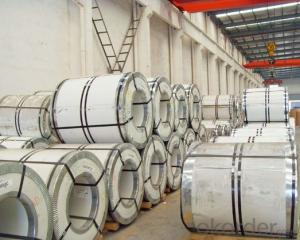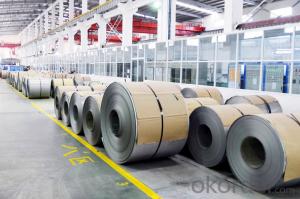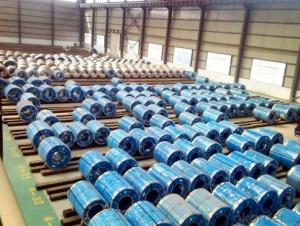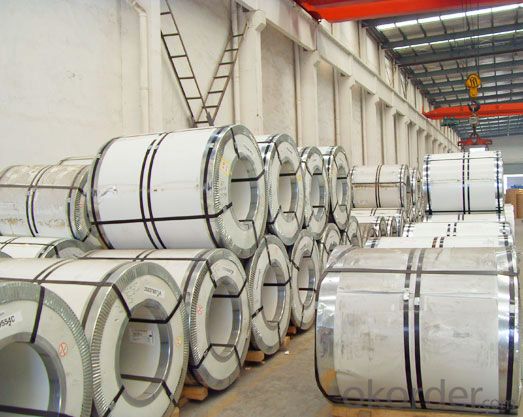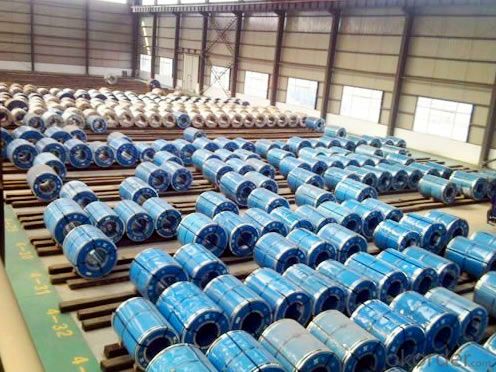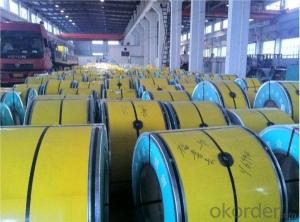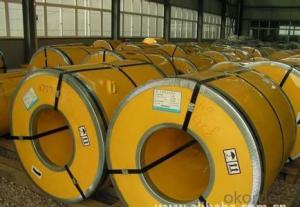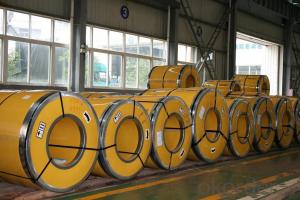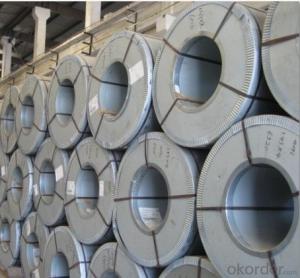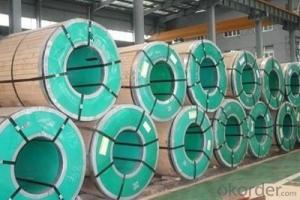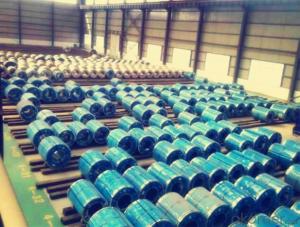Stainless Steel Coil Hot / Cold Rolled 304/316 NO.1/ 2B/ BA
- Loading Port:
- Tianjin
- Payment Terms:
- TT OR LC
- Min Order Qty:
- 20 m.t.
- Supply Capability:
- 4000 m.t./month
OKorder Service Pledge
OKorder Financial Service
You Might Also Like
Hot rolled & Cold rolled Stainless Steel Sheet/ Coil 304/ 316/ 304L/ 316L
Product details:
Item | 304/ 316 stainless steel coil manufacturer |
Technical | Hot rolled and cold rolled |
Standard | ASTM A240,GB/T3280-2007,JIS4304-2005,ASTM A167,EN10088-2-2005,etc |
Surface | 2B,2D,BA,NO.1,NO.4,NO.8, 8K, mirror ,checkered ,embossed ,hair line, sand blast, etching, etc |
Thickness | 0.01~30mm |
Width | 1000mm,1219mm,1500mm,1800mm,2000mm,2500mm,etc |
Package | Standard export package, suit for all kinds of transport, or as required |
MOQ | 20mt |
Export to | Ireland,Singapore,Indonesia,Ukraine,Saudi Arabia,Spain,Canada,USA, Brazil,Thailand,Korea,Iran,India,Egypt,Malaysia,Dubai,Viet Nam,Peru,Mexico,South Africa,Kuwait,Oman,Russia,etc |
Container Size | 20ft GP:5898mm(Length)x2352mm(Width)x2393mm(High) 40ft GP:12032mm(Length)x2352mm(Width)x2393mm(High) 40ft HC:12032mm(Length)x2352mm(Width)x2698mm(High) |
Application | Stainless steel coil applies to construction field, ships building industry, petroleum, chemical industries, war and electricity industries, food processing and medical industry, boiler heat exchanger, machinery and hardware fields. Stainless steel coil can be made according to the customers requirements. |
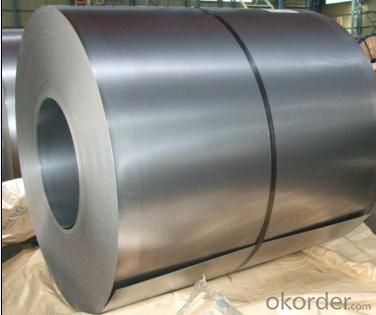
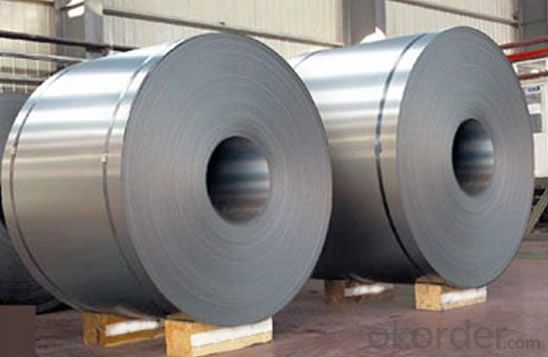
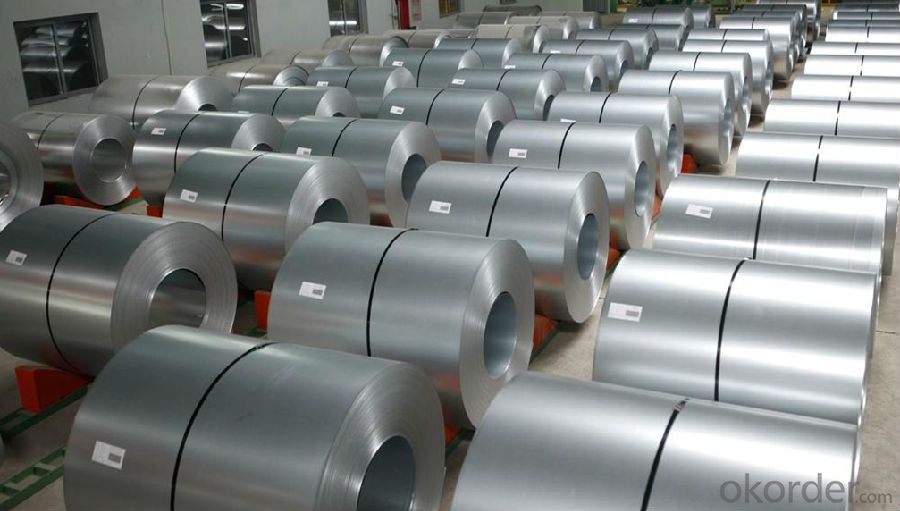
- Q: What is the thickness range for stainless steel strips?
- The thickness range for stainless steel strips can vary, but it typically falls within the range of 0.02 to 5 millimeters.
- Q: What are the different types of surface finishes available for stainless steel strips?
- There are several types of surface finishes available for stainless steel strips, including mirror, brushed, satin, and bead blasted finishes. These finishes vary in terms of appearance and texture, offering options for different aesthetic preferences and functional requirements.
- Q: What are the common uses of stainless steel strips in the food packaging industry?
- Stainless steel strips find various common uses in the food packaging industry due to their unique properties and capabilities. Some of the key uses include: 1. Sealing: Stainless steel strips are often used for sealing food packaging materials such as plastic bags or containers. Their high strength and durability ensure a tight and secure seal, preventing any leakage or contamination. 2. Fastening: These strips are also used for fastening different components of food packaging machinery or equipment. Their resistance to corrosion and high temperatures makes them suitable for fastening purposes, ensuring a secure and long-lasting connection. 3. Conveyor Systems: Stainless steel strips are widely used in the construction of conveyor systems within the food packaging industry. They provide a smooth and hygienic surface for the movement of food products, ensuring cleanliness and preventing any potential contamination. 4. Support Structures: Stainless steel strips are utilized in the fabrication of support structures for food packaging machinery or equipment. Their high strength-to-weight ratio allows for the construction of sturdy and reliable support systems, ensuring stability and efficient operation. 5. Heat Transfer: Stainless steel strips are often incorporated into heat exchangers or heating systems within the food packaging industry. Their excellent thermal conductivity enables efficient heat transfer, contributing to the preservation and sterilization of food products during packaging. 6. Hygiene and Cleanliness: Stainless steel strips are highly resistant to corrosion, staining, and bacterial growth, making them ideal for applications where hygiene and cleanliness are crucial. They are widely used in food packaging machinery or equipment that comes into direct contact with food products, ensuring a safe and sanitary packaging process. In summary, stainless steel strips are versatile and essential components in the food packaging industry. Their sealing, fastening, conveyor, support, heat transfer, and hygiene properties make them invaluable for ensuring the safety, reliability, and efficiency of food packaging processes.
- Q: How do stainless steel strips resist crevice corrosion in seawater?
- Stainless steel strips resist crevice corrosion in seawater primarily due to their high chromium content, which forms a protective oxide layer on the surface. This oxide layer acts as a barrier, preventing oxygen and chloride ions from reaching the metal beneath and thus inhibiting the corrosion process. Additionally, stainless steel strips are often alloyed with other elements such as nickel and molybdenum, further enhancing their resistance to crevice corrosion in the aggressive seawater environment.
- Q: Are 111 stainless steel strips magnetic?
- Yes, 111 stainless steel strips are magnetic. Stainless steel is a general term used to describe a group of alloys that contain a minimum of 10.5% chromium content by mass. The addition of chromium to the steel makes it resistant to corrosion and tarnishing. However, certain grades of stainless steel, such as the 111 series, still retain magnetic properties. This is due to the presence of other elements in the alloy, such as nickel and manganese, which can enable magnetism. Therefore, 111 stainless steel strips can be attracted to magnets and exhibit magnetic behavior.
- Q: Can stainless steel strips be used in the production of architectural façades?
- Yes, stainless steel strips can be used in the production of architectural façades. Stainless steel is a durable and corrosion-resistant material that can withstand various weather conditions, making it an ideal choice for façade applications. Additionally, stainless steel offers a sleek and modern aesthetic, making it popular in contemporary architectural designs.
- Q: How do you cut stainless steel strips?
- To cut stainless steel strips, there are a few methods you can use depending on the thickness and length of the strips. Here are a few common ways to cut stainless steel strips: 1. Manual cutting tools: For thinner stainless steel strips, you can use manual cutting tools such as tin snips or aviation snips. These tools have sharp blades that can easily cut through the stainless steel. However, keep in mind that they may not be suitable for thicker or larger strips. 2. Power shears: Power shears are handheld electric tools specifically designed for cutting metal sheets, including stainless steel. They provide a more precise and efficient cutting process compared to manual tools. Power shears are ideal for cutting stainless steel strips of various thicknesses. 3. Metal cutting bandsaw: If you are dealing with thicker or longer stainless steel strips, a metal cutting bandsaw is a great option. This machine uses a continuous loop blade with teeth designed for cutting through metal. It offers a smooth and accurate cut, making it suitable for industrial applications. 4. Plasma cutter: A plasma cutter is a high-powered tool that uses an electric arc and compressed air to cut through various metals, including stainless steel. It can handle thicker stainless steel strips and provides a clean and precise cut. However, plasma cutters are more expensive and require some level of expertise to operate safely. When cutting stainless steel strips, always ensure you are wearing appropriate protective gear, such as safety glasses and gloves. Additionally, make sure the stainless steel strip is securely clamped or held in place to prevent it from moving during the cutting process.
- Q: Can stainless steel strips be used in power generation plants?
- Power generation plants frequently employ stainless steel strips for a variety of purposes. Stainless steel is an incredibly durable and versatile material that can withstand corrosion, heat, and pressure, making it an excellent choice for numerous applications within these plants. One primary application of stainless steel strips in power plants is the construction of heat exchangers. These devices are vital for transferring heat from one medium to another, such as converting steam into electricity. Stainless steel's resistance to corrosion and ability to withstand high temperatures make it an ideal material for heat exchanger tubes, ensuring their longevity and efficiency. Stainless steel strips are also utilized in the fabrication of various components in power plants, including valves, pumps, and piping systems. The material's strength, resistance to corrosion, and ability to endure high-pressure environments make it suitable for these critical applications. Moreover, stainless steel strips are frequently employed in the production of turbine blades and other parts for steam and gas turbines. These components are exposed to extreme temperatures and mechanical stresses, and stainless steel's capacity to retain its strength and shape under such conditions makes it a reliable choice. Additionally, stainless steel is favored in power generation plants due to its hygienic properties. It is easy to clean and maintain, ensuring that the equipment remains free from contaminants and does not compromise the plant's operations. To summarize, stainless steel strips are commonly used in power generation plants because of their resistance to corrosion, tolerance for high temperatures, strength, and hygienic qualities. From heat exchangers to turbine components, stainless steel is a versatile material that contributes to the efficiency and reliability of power generation processes.
- Q: How do stainless steel strips resist stress corrosion cracking in sulfuric acid?
- Due to their unique composition and properties, stainless steel strips exhibit exceptional resistance against stress corrosion cracking in sulfuric acid. These strips primarily consist of iron, chromium, and nickel, as well as other alloying elements. Chromium plays a crucial role in conferring corrosion resistance by creating a passive oxide layer on the strip's surface, which acts as a protective barrier against corrosive surroundings. In the scenario of sulfuric acid, the inclusion of chromium in stainless steel strips results in the formation of a stable and continuous chromium oxide layer. This layer acts as a safeguard, preventing direct contact between the acid and the underlying metal. The sulfuric acid reacts with the oxide layer, producing a thin coating of metal sulfate on the surface. This coating is highly insoluble and provides an additional defense against further corrosion. Moreover, stainless steel strips often contain a higher concentration of nickel, which enhances their capacity to resist stress corrosion cracking. Nickel enhances the material's ductility and toughness, making it more resistant to the creation and propagation of cracks under stress. It also helps maintain the integrity of the passive oxide layer, ensuring long-term protection against corrosion. Additionally, the specific composition and manufacturing processes employed in the production of stainless steel strips can further augment their resistance to corrosion. For instance, the inclusion of molybdenum improves their ability to withstand pitting and crevice corrosion, which can be particularly problematic in sulfuric acid environments. In summary, the ability of stainless steel strips to resist stress corrosion cracking in sulfuric acid is primarily attributed to the formation of a passive oxide layer, the presence of alloying elements like chromium and nickel, and the inclusion of additional elements such as molybdenum. These factors collaborate to deliver excellent corrosion resistance, establishing stainless steel strips as a dependable and durable choice for applications in sulfuric acid environments.
- Q: What is the coefficient of expansion for stainless steel strips?
- The coefficient of expansion for stainless steel strips varies depending on the specific grade and composition of the stainless steel. However, on average, the coefficient of linear expansion for stainless steel is around 17-19 x 10^-6 per degree Celsius. It is important to note that different types of stainless steel may have slightly different coefficients of expansion, so it is always recommended to consult the manufacturer's specifications for the specific grade of stainless steel being used.
Send your message to us
Stainless Steel Coil Hot / Cold Rolled 304/316 NO.1/ 2B/ BA
- Loading Port:
- Tianjin
- Payment Terms:
- TT OR LC
- Min Order Qty:
- 20 m.t.
- Supply Capability:
- 4000 m.t./month
OKorder Service Pledge
OKorder Financial Service
Similar products
Hot products
Hot Searches
Related keywords
